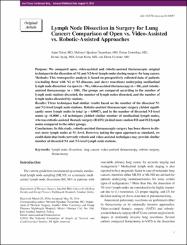Lymph node dissection in surgery for lung cancer: Comparison of open vs. video-assisted vs. robotic-assisted approaches
Künye
Toker A, Ozyurtkan MO, Demirhan O, Ayalp K, Kaba E, Uyumaz E. Lymph Node Dissection in Surgery for Lung Cancer: Comparison of Open vs. Video-Assisted vs. Robotic-Assisted Approaches. Ann Thorac Cardiovasc Surg. 2016. doi: 10.5761/atcs.oa.16-00087Özet
Purpose: We compared open, video-assisted and robotic-assisted thoracoscopic surgical techniques in the dissection of N1 and N2-level lymph nodes during surgery for lung cancer.
Methods: This retrospective analysis is based on prospectively collected data of patients (excluding those with N2 or N3 diseases, and sleeve resections) undergoing mediastinal lymph node dissection via open (n = 96), video-assisted thoracoscopy (n = 68), and robotic-assisted thoracoscopy (n = 106). The groups are compared according to the number of lymph node stations dissected, the number of lymph nodes dissected, and the number of lymph nodes dissected by stations.
Results: Three techniques had similar results based on the number of the dissected N1 and N2-level lymph node stations. Robotic-assisted thoracoscopic surgery yielded significantly more lymph nodes in total (p = 0.0007), and in the number of dissected N1-level nodes (p <0.0001). All techniques yielded similar number of mediastinal lymph nodes, whereas robotic-assisted thoracic surgery (RATS) yielded more station #11 and #12 lymph nodes compared to the other groups.
Conclusions: In this study, robotic-assisted thoracoscopic surgery has been shown to dissect more lymph nodes at N1 level. However, taking the open approach as standard, we could claim that both currently robotic and video-assisted techniques may provide similar number of dissected N1 and N2-level lymph node stations.
Kaynak
Annals of Thoracic and Cardiovascular SurgeryBağlantı
https://hdl.handle.net/11446/1080https://www.jstage.jst.go.jp/article/atcs/advpub/0/advpub_oa.16-00087/_article


















